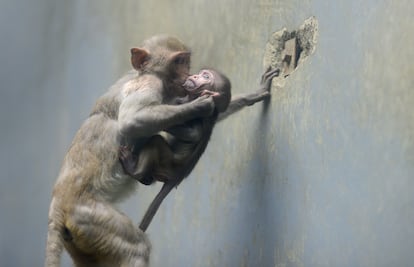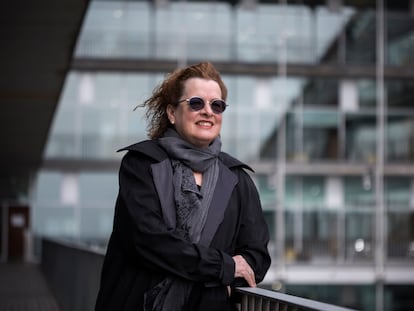Three monkeys impregnated with pseudo-embryos offer insights into the greatest mystery of human pre-natal development
Chinese scientists reveal an ethical technique for studying the first days of pregnancy

Everyone on Earth started as a blastocyst – a tiny ball the size of the period at the end of this sentence. Blastocysts are five-day-old embryos with about 200 cells that implant themselves in the wall of a mother’s uterus. On day 14 of a pregnancy, the mysterious process of gastrulation begins. In about a week’s time, the little ball of cells develops into the first three-dimensional outline of a person: left and right, up and down, front and back. These first days of pregnancy are shrouded in mystery because of the physical and ethical obstacles to studying the process in humans. A team of Chinese scientists recently developed macaque pseudo-embryos in a laboratory, and successfully implanted them in the uterus of three monkeys to initiate pregnancies. The scientists believe that this new embryo model will help us understand why 25% of human pregnancies end in miscarriages and shed light on how birth defects develop.
The cells of a blastocyst are pluripotent, meaning they can more than one cell or tissue type –brain, liver or heart. And they have another amazing capacity. Individually extracted and cultured in the laboratory, they can divide and replicate indefinitely. These are called embryonic stem cells. French scientist Nicolas Rivron used pluripotent cells in 2021 to create human blastocyst models and simulate implantation at the Institute for Molecular Biotechnology in Vienna. Chinese researchers led by neuroscientist Zhen Liu have now gone a step further and transferred these pseudo-embryos called blastoids into the wombs of eight monkeys. The blastoids implanted themselves in the uterus of three monkeys, the first step in a pregnancy.
Gastrulation is probably the most important week in the life of a human being. A divinely perfect choreography begins on that 14th day when the blastocyst develops into the three layers that become the basis for everything else. Over 30 years ago, British embryologist Lewis Wolpert famously said, “It is not birth, marriage or death, but gastrulation, which is truly the most important time in your life.” It’s easy to detect that the process has begun because in the third week of an embryo’s development, mothers feel the pregnancy for the first time with the onset of nausea and vomiting. And that’s when the greatest mystery in pre-natal human development begins.
It was a historic day for science. On July 25, 1978, the first “test-tube baby” was born from a laboratory-fertilized egg. Louise Brown’s birth immediately triggered a debate about the social, ethical and legal implications of this development in human-assisted reproduction. English philosopher Mary Warnock was commissioned by the British government to chair an inquiry into these questions. Warnock’s 1984 report said until day 14, embryos are just a bunch of disorganized cells, with no trace of a nervous system. It was morally acceptable to do research on those little balls and then destroy them. But keeping a living embryo in the laboratory for over 14 days should be a criminal offense, said the report. The 14-day rule proposed in 1984 has been a worldwide do-not-cross line ever since, which is why developing pseudo-embryos that mimic the development of real embryos became so important.
Spanish biologist Marta Shahbazi says Zhen Liu’s team at the Shanghai Neurosciences Institute has successfully developed the first monkey embryo model at the blastocyst stage. “The innovation is technical, not conceptual,” said Shahbazi, who cultivates human embryos up to the 14-day limit at the University of Cambridge’s Laboratory of Molecular Biology (UK). “They developed them [macaque blastoids] in vitro and revealed some important characteristics of the gastrulation stage. In this respect, it seems more advanced than human models,” she said.
Shahbazi cautions that the new model is not perfect. “Some cells do not have a clear identity and the process efficiency is low, but I’m sure these limitations will be overcome,” she said. The Chinese researchers used a chemical cocktail to induce self-renewal of monkey embryonic stem cells into blastocyst-like structures, with a 25% efficiency rate. Blastoids attached themselves to the uterine walls of three monkeys, but none subsisted for more than a week. The blastoids were cultured in a laboratory environment and even developed the precursor cells of the circulatory system, which usually happens on day 17 of a pregnancy – the beginning of the elusive gastrulation process.
“It [the Cell Stem Cell article] clearly shows that these model embryos cannot develop in a mother’s uterus. In other words, they are not embryos, they are simply models,” said Shahbazi. This is an important point. In countries like Australia, human blastocyst models, similar to the ones developed by Nicolas Rivron, are considered embryos and are strictly regulated by laws applying to genuine human embryos. “This article clearly shows that we cannot carry a pregnancy to term with our current technology. I don’t think the next research steps need to go that far. Let’s start by demonstrating that models can gastrulate in vivo [in the monkey uterus] and begin the process of organ formation,” said Shahbazi, who was not involved in the Chinese study.
French biologists Irène Aksoy and Pierre Savatier have created monkey and human chimeras (organisms with genetically distinct cells originating from two or more zygotes) in their Lyon (France) laboratory. They developed macaque embryos with just 250 cells, 10 of which were human. This is another alternative to using fully human embryos in scientific experiments. Aksoy, who works in France’s Stem Cell and Brain Research Institute (INSERM), believes the new monkey blastoids will shed light on the inscrutable process of embryo implantation in the womb.
Since these blastoids cannot develop into a viable fetus, there are no legal problems for conducting research with them. But Aksoy warns that this may change. “If one day a monkey blastoid has the same developmental potential as a normal monkey embryo, then Catholic conservatives will want to give human blastoids the same ethical status as a real embryo. They will say it’s immoral to work with human blastoids.” And Aksoy warns of another ethical issue. “Allowing a malformed, diseased and suffering fetus to develop and be born is a long-term risk that is ethically unacceptable.”
Sign up for our weekly newsletter to get more English-language news coverage from EL PAÍS USA Edition
Tu suscripción se está usando en otro dispositivo
¿Quieres añadir otro usuario a tu suscripción?
Si continúas leyendo en este dispositivo, no se podrá leer en el otro.
FlechaTu suscripción se está usando en otro dispositivo y solo puedes acceder a EL PAÍS desde un dispositivo a la vez.
Si quieres compartir tu cuenta, cambia tu suscripción a la modalidad Premium, así podrás añadir otro usuario. Cada uno accederá con su propia cuenta de email, lo que os permitirá personalizar vuestra experiencia en EL PAÍS.
¿Tienes una suscripción de empresa? Accede aquí para contratar más cuentas.
En el caso de no saber quién está usando tu cuenta, te recomendamos cambiar tu contraseña aquí.
Si decides continuar compartiendo tu cuenta, este mensaje se mostrará en tu dispositivo y en el de la otra persona que está usando tu cuenta de forma indefinida, afectando a tu experiencia de lectura. Puedes consultar aquí los términos y condiciones de la suscripción digital.
More information
Últimas noticias
Most viewed
- Christian Louboutin: ‘Young people don’t want to be like their parents. And if their parents wear sneakers, they’re going to look for something else’
- ‘El Limones’ and the growing union disguise of Mexican organized crime
- Cartels in Mexico take a leap forward with narco-drones: ‘It is criminal groups that are leading the innovation race’
- The low-cost creative revolution: How technology is making art accessible to everyone
- ‘We are dying’: Cuba sinks into a health crisis amid medicine shortages and misdiagnosis











































